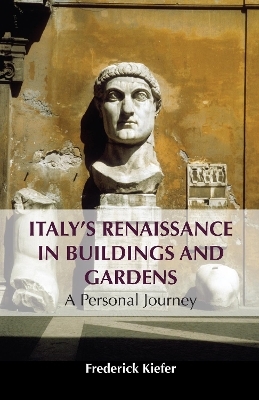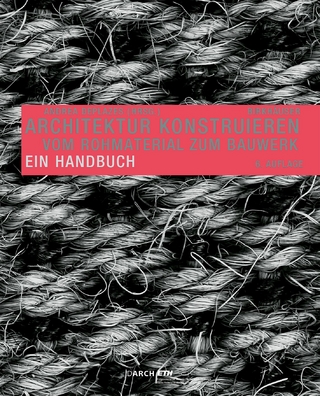
Italy’s Renaissance in Buildings and Gardens
Anthem Press (Verlag)
978-1-83999-279-7 (ISBN)
Palaces, villas and churches. These were the highlights of my first visit to Italy. I took a lot of photos and looked forward to sharing them with friends and family. Back home, though, I found that I didn’t recall much about the places that impressed me. Although I had the benefit of a half-day guide in Rome, Florence and Venice, I sometimes had difficulty hearing what was said on crowded streets and busy interiors. The guides were capable but had only enough time to mention a few major features. As a rule, they skimped on actually describing buildings that intrigued me. And so they were not especially helpful in providing the insights I wanted. Upon my return, I found myself wondering: Where did the architects actually find their ideas? What did they want to accomplish? And what do their choices tell us about their time? My sojourn in Italy would have been more satisfying if I had come away with a fuller account of what I had seen. What I most needed was context. This book supplies that context.
Contemplation of antiquity and the exchange of views among architects released a surge of intellectual energy not seen for a millennium, a development that would never have happened so quickly were it not for Johannes Gutenberg’s invention of printing with movable type. This development, in turn, led to architects’ heightened self-awareness of their collective enterprise. They read what their fellow architects wrote and thereby gained in sophistication. They were no longer merely masons. They became architects in the modern sense. They took pride in their achievements and shared a conviction that the visual culture they created was far superior to that of the previous thousand years.
Their embrace of classical civilisation had a visceral urgency. Rome, after all, was a culture with a storied past, peopled by larger-than-life figures. To learn what the ancients had created in word or stone could supply a shortcut to wisdom. And emulating the Romans would provide new models of aesthetic excellence. This endeavour became known as the Renaissance, or rebirth. The Reformation, however, changed everything. Martin Luther brought to issue a quandary: How exactly was Christianity to be reconciled with the pagan past, if at all? Could one source of inspiration be sustained without compromising the other? Religious reform questioned the aesthetic achievements of the previous hundred years. The story of Renaissance architecture represents the effort to find an accommodation.
Frederick Kiefer is University Distinguished Professor in the English Department at the University of Arizona, Tucson.
List of Figures; Acknowledgments; Preface; Introduction; PART I FLORENCE; CHAPTER 1 The Foundling Hospital, Florence; CHAPTER 2 San Lorenzo, Florence; CHAPTER 3 Santo Spirito, Florence; CHAPTER 4 The Pazzi Chapel, Florence; CHAPTER 5 The Cathedral Dome; CHAPTER 6 The Medici Palace, Florence; CHAPTER 7 Santa Maria Novella, Florence; CHAPTER 8 The Medici Library, Florence; PART II ROME, CHAPTER 9 The Tempietto, Rome; CHAPTER 10 Villa Chigi/Farnesina, Rome; CHAPTER 11 Villa Madama, Rome; CHAPTER 12 Farnese Palace, Rome; CHAPTER 13 The Casino of Pius IV, Rome; CHAPTER 14 Piazza del Campidoglio, Rome; CHAPTER 15 St. Peter’s Basilica, Vatican City; CHAPTER 16 Farnese Palace, Caprarola; PART III THE NORTH, CHAPTER 17 Sant’Andrea, Mantua; CHAPTER 18 Palazzo Te, Mantua; CHAPTER 19 Sabbioneta and the Ideal City; CHAPTER 20 The Tempio Malatestiano, Rimini; CHAPTER 21 The Ducal Palace, Urbino; CHAPTER 22 Santa Maria della Consolazione, Todi; CHAPTER 23 Santa Maria presso San Satiro, Milan; CHAPTER 24 Villa Barbaro, Maser; PART IV VENICE AND ENVIRONS, CHAPTER 25 The Basilica, Vicenza; CHAPTER 26 Villa Rotonda, Vicenza; CHAPTER 27 Olympic Theater, Vicenza; CHAPTER 28 Teatro all’antica, Sabbioneta; CHAPTER 29 St. Mark’s Library, Venice; CHAPTER 30 Grimani Palace, Venice; CHAPTER 31 Il Redentore, Venice; PART V GARDENS, CHAPTER 32 Villa d’Este Garden, Tivoli; CHAPTER 33 Villa Lante Garden, Bagnaia; CHAPTER 34 Sacro Bosco, Bomarzo; Conclusion; Postscript; Notes; Bibliography; Index
| Erscheinungsdatum | 12.09.2024 |
|---|---|
| Verlagsort | London |
| Sprache | englisch |
| Maße | 140 x 216 mm |
| Gewicht | 454 g |
| Themenwelt | Technik ► Architektur |
| ISBN-10 | 1-83999-279-4 / 1839992794 |
| ISBN-13 | 978-1-83999-279-7 / 9781839992797 |
| Zustand | Neuware |
| Informationen gemäß Produktsicherheitsverordnung (GPSR) | |
| Haben Sie eine Frage zum Produkt? |
aus dem Bereich


